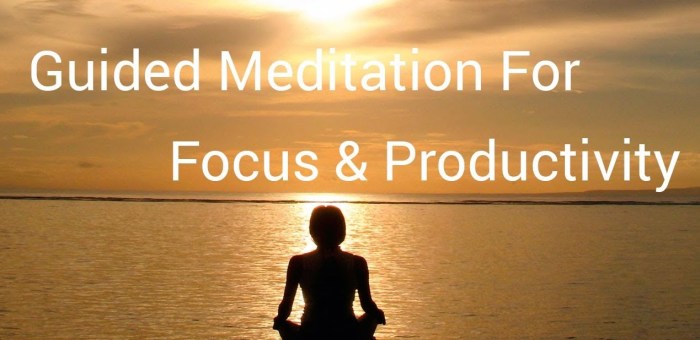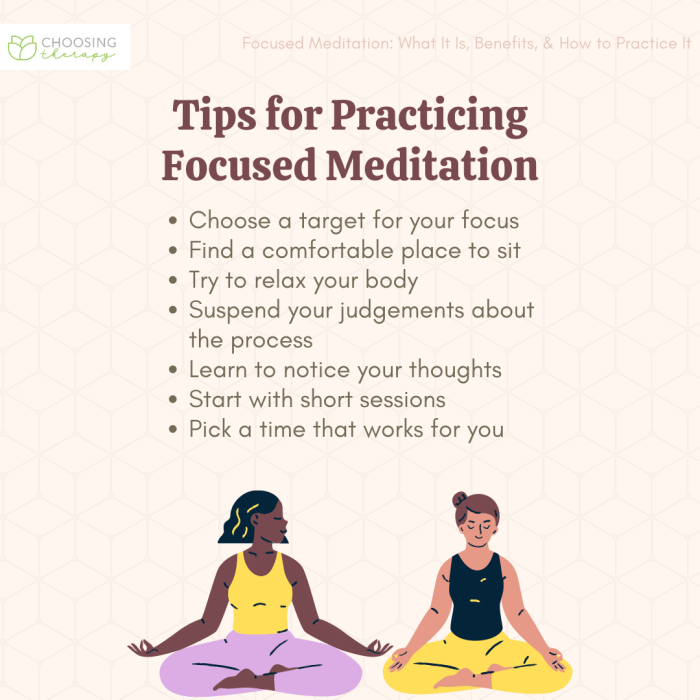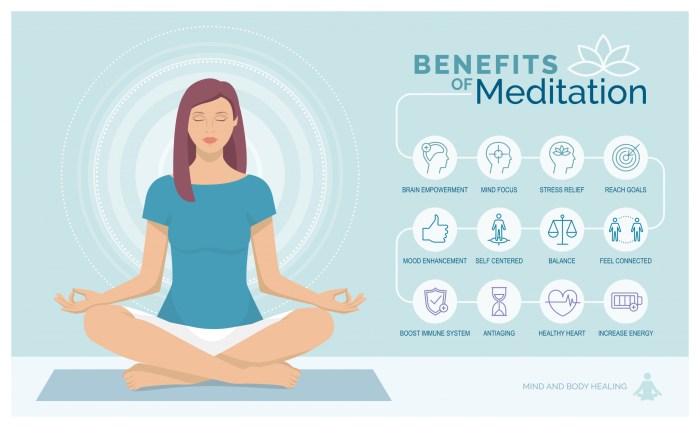Embark on a journey of self-discovery and mental clarity with 12 Guided Meditations for Enhanced Focus. Dive into the world of mindfulness and explore techniques that will sharpen your attention and boost your productivity.
Uncover the secrets behind guided meditations designed to improve focus and learn how to incorporate these practices into your daily routine for lasting benefits.
Introduction to Guided Meditations

Guided meditations are a form of meditation where an individual is led through a specific meditation practice by a trained guide or through recorded audio or video. The purpose of guided meditations is to help individuals focus their mind, relax their body, and achieve a state of deep concentration.
Guided meditations differ from traditional meditation practices in that they provide a structured framework for the meditation session. The guide typically gives instructions on breathing techniques, visualization, and mental focus, making it easier for beginners to stay on track and deepen their practice.
Benefits of Guided Meditations for Enhancing Focus
- Guided meditations offer a clear direction: By following the voice of the guide, individuals are able to stay present and focused on the meditation practice without getting distracted.
- Helps in reducing stress and anxiety: Guided meditations often include relaxation techniques that can help calm the mind and body, allowing for better focus and concentration.
- Enhances mindfulness: Through guided meditations, individuals can develop greater awareness of their thoughts and emotions, leading to improved focus and attention in daily tasks.
- Improves mental clarity: By practicing guided meditations regularly, individuals can sharpen their mental faculties, making it easier to concentrate and stay focused on important tasks.
Types of Guided Meditations for Focus
When it comes to enhancing focus through guided meditation, there are various types of techniques that can be employed to help individuals improve their concentration and attention span.
Mindfulness Meditation, 12 Guided Meditations for Enhanced Focus
- Focuses on bringing attention to the present moment.
- Practitioners are encouraged to observe their thoughts and emotions without judgment.
- Helps in training the mind to stay focused on the task at hand.
Visualization Meditation
- Involves creating a mental image or scenario to focus on.
- Helps in improving concentration by directing the mind towards a specific goal or outcome.
- Effective for enhancing creativity and problem-solving skills.
Body Scan Meditation
- Focuses on bringing awareness to different parts of the body.
- Helps in grounding the mind and increasing bodily awareness.
- Improves focus by promoting relaxation and reducing stress.
Mantra Meditation
- Involves repeating a word or phrase to focus the mind.
- Helps in cultivating a sense of calm and concentration.
- Effective for enhancing mental clarity and reducing distractions.
Scientific Evidence and Studies

Research studies have shown that guided meditations can be highly effective in enhancing focus and concentration. These studies provide valuable insights into the cognitive benefits of meditation practices on the brain.
Impact on Brain Function
- One study published in the journal Psychological Science found that mindfulness meditation can improve cognitive control and enhance working memory capacity.
- Research conducted at the University of California, Santa Barbara, demonstrated that regular meditation practice can lead to structural changes in the brain, specifically in regions associated with attention and sensory processing.
- A study published in the journal Frontiers in Human Neuroscience showed that meditation can increase grey matter density in the brain, particularly in areas related to focus and emotional regulation.
Creating the Right Environment
Setting up the perfect environment for your guided meditation sessions is crucial for achieving enhanced focus and relaxation. Here are some tips to help you create a conducive space for your practice.
Eliminating Distractions
- Avoid noisy areas: Choose a quiet room or corner where you are less likely to be disturbed by external sounds.
- Turn off electronic devices: Minimize distractions by turning off your phone, computer, or any other devices that may interrupt your meditation.
- Inform others: Let family members or roommates know that you need some quiet time for meditation to avoid unexpected interruptions.
Creating a Peaceful Space
- Add calming elements: Use scented candles, essential oils, or incense to create a soothing atmosphere that promotes relaxation.
- Comfortable seating: Choose a comfortable cushion or chair to sit on during meditation to help you relax and focus better.
- Natural light: If possible, meditate in a room with natural light to create a more uplifting and peaceful environment.
Incorporating Breathing Techniques

Breathing techniques play a crucial role in guided meditations for focus as they help calm the mind, reduce stress, and enhance concentration. By incorporating specific breathing exercises, individuals can improve their ability to stay present and attentive during meditation sessions.
Specific Breathing Exercises
- Deep Abdominal Breathing: Start by inhaling deeply through your nose, feeling your abdomen rise as you fill your lungs with air. Hold for a few seconds, then exhale slowly through your mouth, feeling your abdomen fall. Repeat this cycle several times to relax the body and mind.
- Box Breathing: Inhale deeply for a count of four, hold your breath for a count of four, exhale for a count of four, and then hold again for a count of four. This pattern creates a calming rhythm that can help improve focus and clarity.
- Alternate Nostril Breathing: Close one nostril with your thumb and inhale deeply through the other nostril. Then, close the other nostril with your finger, release the thumb, and exhale through the first nostril. Repeat this process, alternating nostrils, to balance the mind and improve concentration.
Controlled Breathing Patterns
Controlled breathing patterns contribute to a focused mind during meditation by regulating the flow of oxygen to the brain and promoting relaxation. When individuals engage in slow, deliberate breathing techniques, they activate the parasympathetic nervous system, which helps reduce stress and increase mental clarity. By focusing on the breath, distractions are minimized, allowing for a deeper sense of concentration and mindfulness.
Body Scan Meditations
Body scan meditations involve focusing on different parts of the body sequentially to increase mindfulness and attentiveness. This practice is beneficial for enhancing focus by promoting a deep connection between the mind and body.
How to Perform a Body Scan Meditation Session
To begin a body scan meditation session for increased concentration, find a quiet and comfortable place to sit or lie down. Close your eyes and start by bringing your awareness to your breath. Slowly shift your focus to different parts of your body, starting from your toes and moving upwards. Notice any sensations without judgment and gently release any tension you may feel.
Continue this process until you have scanned your entire body.
Benefits of Body Scan Meditations
- Enhances Mindfulness: Body scan meditations help in developing a heightened sense of awareness and presence in the moment.
- Promotes Relaxation: By releasing tension in different body parts, this practice can induce a state of deep relaxation.
- Improves Concentration: Focusing on each body part sequentially can improve concentration and mental clarity.
- Reduces Stress: Body scan meditations can help in reducing stress and anxiety by promoting a sense of calmness.
Visualization Practices
Visualization techniques play a crucial role in guided meditations for enhancing focus. By engaging the mind in vivid mental imagery, individuals can sharpen their attention and concentration. Visualizations can stimulate the brain and create a mental environment conducive to deep focus.
Examples of Visualization Techniques
- Imagine a bright, glowing light at the center of your forehead, radiating clarity and focus throughout your mind.
- Picture yourself in a serene forest, each tree representing a task or thought that you need to focus on, guiding you towards mental clarity.
- Visualize a flowing river, symbolizing the stream of your thoughts, calmly moving past distractions and obstacles, allowing you to stay centered and focused.
Mindfulness Meditation
Mindfulness meditation is a practice that involves focusing on the present moment without judgment. It is a significant tool in improving focus as it helps individuals become more aware of their thoughts, emotions, and surroundings, allowing them to redirect their attention back to the task at hand.
Mindfulness Exercises
- Body Scan: In this exercise, individuals focus on each part of their body, starting from the toes and moving up to the head, noticing any sensations or tension.
- Breath Awareness: This involves paying attention to the breath, noticing the inhalation and exhalation without trying to control it.
- Sound Meditation: Practitioners focus on the sounds around them, acknowledging each sound without getting caught up in thoughts about them.
Cultivating Awareness and Attentiveness
Mindfulness meditation cultivates awareness by training individuals to observe their thoughts and feelings without getting carried away by them. This practice helps in developing attentiveness as it allows individuals to notice distractions and bring their focus back to the present moment.
Guided Meditations for Stress Reduction: 12 Guided Meditations For Enhanced Focus
When it comes to enhancing focus, reducing stress plays a crucial role. Guided meditations specifically designed for stress relief can indirectly improve concentration and attention by calming the mind and body, allowing for a clearer and more focused state of being.
Benefits of Guided Meditations for Stress Reduction
- Guided meditation scripts or audio resources focused on reducing stress often incorporate soothing music, gentle guidance, and relaxation techniques to help individuals release tension and anxiety.
- These guided meditations can help individuals let go of worries and negative thoughts, creating a more peaceful and centered mental state conducive to better focus and productivity.
- By reducing stress levels through guided meditations, individuals can experience improved emotional regulation, which can in turn enhance their ability to concentrate and stay present during meditation practices.
Length and Frequency of Practice
When it comes to guided meditations for enhanced focus, the duration and frequency of your practice play a crucial role in achieving optimal results. Finding the right balance is key to reaping the benefits of improved concentration and mindfulness.
Ideal Duration of Guided Meditation Sessions
Guided meditation sessions for focus improvement should ideally last between 10 to 30 minutes. This timeframe allows you to fully immerse yourself in the practice without feeling rushed or overwhelmed. Starting with shorter sessions and gradually increasing the duration as you become more comfortable can be a good approach.
Recommended Frequency of Practicing Guided Meditations
- For beginners, aim to practice guided meditations for focus at least 3-4 times a week.
- As you progress, try to incorporate daily sessions into your routine for more consistent results.
- Consistency is key, so find a schedule that works for you and stick to it to see noticeable improvements in your focus over time.
Developing a Consistent Meditation Schedule
To enhance your focus through guided meditations, it’s essential to establish a consistent practice schedule. Here are some tips to help you stay on track:
- Choose a specific time of day that works best for you, whether it’s in the morning, during a break, or before bed.
- Create a dedicated space for your meditation practice where you can minimize distractions and feel comfortable.
- Set realistic goals and track your progress to stay motivated and committed to your meditation routine.
Tracking Progress and Outcomes

Tracking progress in focus enhancement through guided meditations is essential to gauge the effectiveness of your practice. By monitoring key indicators and changes, you can better understand how meditation is impacting your ability to concentrate.
Methods for Tracking Progress
- Keep a meditation journal: Write down your thoughts, feelings, and experiences before and after each session. Note any improvements in focus or concentration over time.
- Use technology: There are apps and devices available that can track your meditation practice and provide insights into your progress.
- Self-assessment: Reflect on how you feel during daily tasks that require focus. Notice any differences in your ability to stay present and attentive.
Integrating Guided Meditations into Daily Routine

Incorporating guided meditations into your daily routine can greatly enhance your focus and overall well-being. Finding the right time slots and committing to regular practice are key factors in reaping the benefits of meditation.
Strategies for Seamless Integration
- Start your day with a short guided meditation to set a positive tone for the day ahead.
- Integrate meditation breaks into your work schedule to refresh your mind and boost productivity.
- Use guided meditations as a wind-down routine before bed to promote relaxation and better sleep.
Benefits of Regular Practice
- Improved focus and concentration throughout the day.
- Reduced stress and anxiety levels over time.
- Enhanced self-awareness and emotional regulation.
Final Thoughts
Elevate your focus, reduce stress, and cultivate mindfulness with the transformative power of guided meditations. Embrace a new way of thinking and living as you harness the potential of your mind through these structured and purposeful sessions.